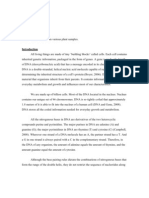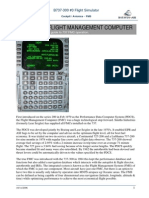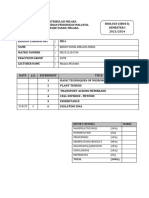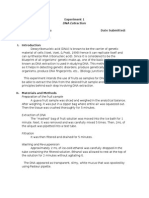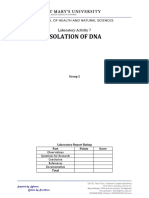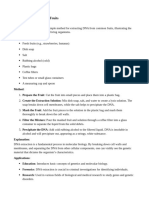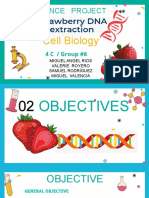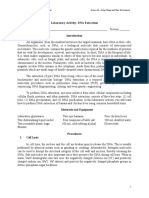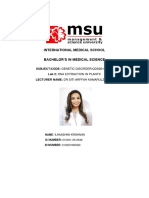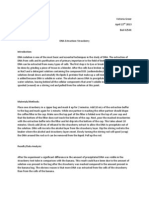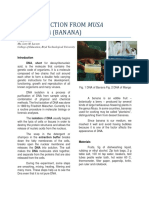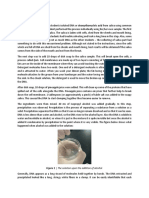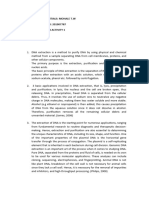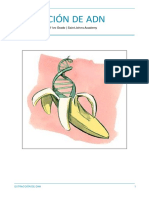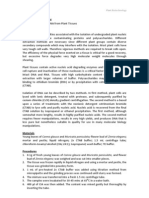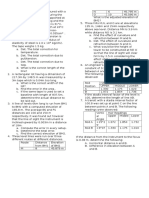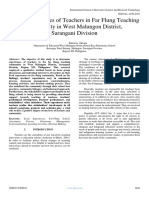Formal Lab Report
Formal Lab Report
Uploaded by
rf5h4h65n6Copyright:
Available Formats
Formal Lab Report
Formal Lab Report
Uploaded by
rf5h4h65n6Copyright
Available Formats
Share this document
Did you find this document useful?
Is this content inappropriate?
Copyright:
Available Formats
Formal Lab Report
Formal Lab Report
Uploaded by
rf5h4h65n6Copyright:
Available Formats
DNA Extraction of a Banana and Visualising
DNA Structures using Microscope Analysis
Louise Olazo1 , Jyra Sheen Cruz 2, John David Borleo 3, Rhyss Caitlin Abac ,4
Jayen Mitch Munsayac 5, Naz Reeno De Dios 6
Junior High School Department (Chemistry Laboratory), St. Paul University at San Miguel
Salangan, 3011 San Miguel, Bulacan, Philippines
louisesolazo@gmail.com
Abstract - Extraction of DNA is often an early step in
I.II DNA Organic Extraction
many diagnostic processes used to detect bacteria and
In following the organic extraction, we break down the
viruses in the environment as well as diagnosing disease
lipids from the cell membrane and the nucleus of our fruit.
and genetic disorders. In our activity, we have decided to
Breaking cells and cell walls allow the DNA to be released
use the Organic Extraction in extracting the DNA of a
from the nucleus. With the addition of salt as well as dish
Banana. This method simplifies the whole process of
soap, these two components help in the precipitation of
extraction, with just the use of household materials such
DNA and to neutralizes the charge on the DNA molecule.
as dish soap, salt, alcohol, and water we are able to break
Ultimately, it does most in breaking down the cell
apart the cellular and nuclear membranes, and it releases
membranes and dissolving the cell components. Organic
the DNA. The salt helps the DNA strands come together
extraction is the main process that makes debris or the
and we used alcohol to precipitate it, since the DNA is
DNA of the fruit accumulate above the solution. As these
not soluble in alcohol. Lastly, we observed our DNA, on
are as seen, and illustrated in Figure 1.1.
a microscope for a better understanding regarding it’s
structure. We were able to successfully conduct a DNA
Extraction of a Banana, and all objectives are attained.
In this laboratory report, we will discuss all the
procedures, outcomes, and gained knowledge of the
following experiment.
KEYWORDS - DNA Extraction of a Banana, Process in
Figure 1.1
Extracting The DNA of a Fruit, DNA Organic Extraction
I.III Banana (Musa acuminata)
A banana is an elongated, edible fruit – botanically a
I. INTRODUCTION berry It is produced by several kinds of large herbaceous
flowering plants in the genus Musa. The fruit is variable in
I.I Deoxyribonucleic acid (DNA) size, color, and firmness, but is usually elongated and
Deoxyribonucleic acid (DNA) is a biological molecule, curved, with soft flesh rich in starch covered with a rind,
which consists of the biological instructions making each which may be green, yellow, red, purple, or brown when
species unique. It carries genetic instructions in all living ripe. We chose to extract the DNA from a Banana for it
beings and makes up the genome of an organism. DNA has a soft, creamy, and smooth consistency when mash or
contains the instructions needed for an organism to blend, which makes it easier. Mashing the banana exposes
develop, survive and reproduce. To carry out these a greater surface area from which to extract the DNA.
functions, DNA sequences must be converted into
messages that can be used to produce proteins, which are I.IV Organic Extraction in Extracting the DNA of a Banana
the complex molecules that do most of the work in our We decided to use the organic extraction method to extract
bodies. Amongst the three methods of DNA Extraction, the DNA from a dragon fruit mostly because it is a cheap
(organic extraction, nonorganic extraction, and but effective way of extracting a good quantity of DNA
absorption method) we have chosen to follow and perform that can serve as a sample for microscopy in order to
the Organic Extraction examine it’s structure.
I.V Objectives
The main aim of this experiment is to have a
deeper understanding about the Deoxyribonucleic
Acid that is found in nearly all living cells and the
process of extracting it.
So, the main objective of this experiment is to fulfil
the following:
To understand the process and importance of
DNA extraction from a fruit.
To study the structure and properties of DNA. Figure II.I Figure II.II
To encourage critical thinking and problem-
2. While macerating the fruit, other members of the group
solving skills by performing the DNA extraction
also started to make the salt solution. In a 100 mL of
experiment. distilled water, we added a 1.5 grams of table salt (sodium
To foster a deeper understanding of genetics and chloride) and gently stirred it with a spoon until the salt is
molecular biology concepts through hands-on dissolved. In this step, salt helps in the precipitation of
experimentation. DNA from a solution, it neutralizes the charge on the
To inspire curiosity and interest in the field of DNA molecule, causing it to become less soluble in water.
DNA research and genetic engineering. This makes it easier to separate the DNA from other
cellular components. It also helps in the dissociation of
proteins from DNA, the positive ions present in the salt
II. METHODOLOGY solution bind to the negatively charged proteins, disrupting
DNA extraction is a fundamental process in their interactions with DNA. This helps in the removal of
proteins and other impurities from the DNA solution.
molecular biology that is performed to isolate
DNA from various sources, including fruits. This
methodology aims to describe a simple and
efficient procedure for extracting DNA from a
fruit sample.
II.I Needed Materials
The materials that are used for this DNA
Extraction of a Fruit are the following :
Banana
Ziplock plastic bag Figure II.III Figure II.IV
Liquid dish soap 3. Then, we added a 5 mL of liquid dishwashing detergent and
add it to the saltwater solution. We mixed it gently to form a
Table salt (sodium chloride)
soapy solution. The addition of dish soap in DNA extraction
Water helps in breaking down the cell membranes and dissolving the cell
Iced Cold Ethanol components. The cell membrane acts as a barrier, protecting the
Strainer genetic material inside the cells. By adding dish soap, the lipid
Wooden Stick bilayer is disrupted, and the cell membrane breaks apart,
allowing the DNA to be released into the solution. This is an
Cup important step for DNA extraction because one of the main
purposes of this experiment is to isolate the DNA from the other
II.II Process
cell components to study or analyze it.
1. Sliced pieces of a one and a half banana were put
into a Ziplock bag, and macerenated by hand
until they turn into a mushy pulp. This step break
cells and cell walls which then allowed the DNA to
be released from the nucleus. The more we
mashed the banana, the more thin the consistency
will be, in which then results for more DNA to be
released from the fruit.
Figure II.V Figure II.VI
4. Next, we poured the mashed banana mixture from the III. OBSERVATIONS AND OUTCOMES
Ziplock bag through a sieve/strainer into the cup, allowing
the liquid to pass through while trapping any solid particles Overall, the process of extracting DNA from a
in the filter. This concentrates the DNA sample and banana demonstrates the ability to isolate and
remove excess fluids, and improves the purity, and quality observe the genetic material present in living
of the extracted DNA. organisms. It also shows the importance of breaking
down cellular structures, lipids, and proteins to
access and separate DNA from other components.
As you can see in
the view of the
microscope, you
can observed the
molecules of the
DNA Extracted
Figure II.VII Figure II.VIII from the Banana
5. Then we pour the cold alcohol down the side of the cup looks like a
into the sieved banana mixture and waited a while for the droplets of water
DNA to float on top. The DNA clumps are soluble in coiled up together Figure III.I.
some liquids, but not in alcohol. So adding an ice cold in a form of rungs Lense - 4x
ethanol makes the DNA to come out of the solution and in a ladder. Magnification - 64x
form a visible white precipitate, clumps or strands that can
be easily collected.
Through the Mid-
Power Objective
Lense of the
microscope, we can
now see a more
define and enlarge
picture of the lines
and shapes and
particles of the
DNA. Figure III.II
Lense - 10x
Figure II.IX
Magnification - 160x
6. As for the last step, we insert a wooden stick into the cup Through the High-
gently swirl it to collect the DNA strands around the stick Power Objective Lens,
or spoon and then we transfer the DNA strand into a this helps us see a
microscope glass side and covered it with a cover slip. After larger structure and
that we proceed into examining and observing the physical provides a close up
structures of the DNA of a Banana through a microscope look at the DNA
using low-power, medium-power, and high-power particles. It appear as
a thin, thread-like
objective lenses.
structures or fibers.
However, despite the
use of microscope and
it’s different lenses, It
is typically not visible
as a distinct shape or
pattern and to Figure III.III
actually observe and Lense - 40x
examine the precise Magnification - 640x
appearance of DNA
without specialized
Figure II.X Figure II.XI staining or
visualization
techniques.
We would like to acknowledge every member of our
IV. CONCLUSION group, for their cooperation in this DNA activity.
The extraction of DNA from a banana is an We would like to thank sir Romnick Inducil for
enthralling illustration of molecular biology in teaching and helping us to make this experience a
action. First, we mashed the banana to break down memorable one.
the cell walls and release the cellular contents, and
then a a salt solution and detergent are added to the We would also like to thank our Lord for giving us
mashed banana to break down the lipid membranes this opportunity to properly execute this laboratory
and proteins, releasing the DNA, and lastly the experiment that tackles about the basic unit of life.
addition of a cold alcohol causes the DNA to
precipitate out of the solution since DNA is We are also thankful for the opportunity to
insoluble in alcohol. And after all the process and participate in this DNA experiment that has been
procedure, we were able to see the extracted DNA eye-opening and thought-provoking.
as a stringy, white substance floating in the alcohol
layer. Through this experiment, we were able to uncover
and understand the mysteries of DNA, the building
After successfully extracting the DNA from the blocks of life. We are incredibly grateful for the
banana, we then moved to examining the structure opportunity to engage in this scientific exploration
under a microscope to determine its structure. Due which deepens our understanding of this fascinating
to their small size, the DNA strands extracted from subject.
a banana is not that visible under a light
microscope. They look like a fine, tangled mass that VI. REFERENCES
is difficult to resolve.
The extraction of DNA from a banana and its [1] R. P. Hearn, K. E. Arblaster.
DNA extraction techniques for use in education, 2010
microscopic examination provide an intriguing
https://iubmb.onlinelibrary.wiley.com/doi/10.1002/bmb.20351
glimpse into the world of molecular biology. This
essential genetic material is found in bananas, as it [2] 5 A,Lum,M. L. Le ( 1998) A method for obtaining genomic
is in all living organisms. While the extraction DNA in molecular epidemiological studies. Biomarkers Prev. 7,
process can be done with common household items 719–724.
and basic laboratory equipment, advanced
microscopy techniques can reveal the true beauty Gupta N. DNA Extraction and Polymerase Chain Reaction. J
and complexity of DNA's structure. The ability to Cytol. 2019 Apr-Jun;36(2):116-117. doi:
extract and observe DNA from a banana 10.4103/JOC.JOC_110_18. PMID: 30992648; PMCID:
PMC6425773.
demonstrates not only the ubiquity of DNA in
nature, but also the remarkable progress in scientific https://www.ncbi.nlm.nih.gov/pmc/articles/PMC6425773/
methods for studying the genetic code that
underpins all life on Earth.
V. ACKNOWLEDGEMENTS
First and foremost, we are thankful that this
experiment allowed us to witness firsthand the
complexity and intricacies of DNA. By extracting
DNA from a simple Banana, we were able to see the
double helix structure and learn about the different
components that make up DNA, which was truly
remarkable to witness.
You might also like
- Batch Determination According To Shel Life ExampleDocument18 pagesBatch Determination According To Shel Life ExampleKhalil EL KARAMANo ratings yet
- Day 1 Mission NEETPGDocument142 pagesDay 1 Mission NEETPGKalyan SagarNo ratings yet
- DNA ExtractionDocument6 pagesDNA ExtractionWei Loon100% (1)
- DNA Extraction of Ananas Comosus (Pineapple) : P U P College of Science Department of BiologyDocument12 pagesDNA Extraction of Ananas Comosus (Pineapple) : P U P College of Science Department of BiologyJudy Anne Vitales GalizaNo ratings yet
- Lab Report 4 DNA IsolationDocument6 pagesLab Report 4 DNA IsolationPriyo Priyonti100% (3)
- Inorganic PolymersDocument353 pagesInorganic Polymerskl42c4300100% (1)
- HRM in NestleDocument21 pagesHRM in NestleKrishna Jakhetiya100% (1)
- Flight Management ComputerDocument19 pagesFlight Management ComputerNarablues IndonesiaNo ratings yet
- Philosophical Inquiry: Prepared By: Ms. Elaine J. RiñonDocument19 pagesPhilosophical Inquiry: Prepared By: Ms. Elaine J. RiñonElaine RiñonNo ratings yet
- DNA ExtractionDocument4 pagesDNA ExtractionheyahroxNo ratings yet
- Experiment 6 Isolating Dna From Fruit h1p8Document5 pagesExperiment 6 Isolating Dna From Fruit h1p8Hazim Awwami100% (3)
- EXPERIMENT 1. DNA ExtractionDocument3 pagesEXPERIMENT 1. DNA ExtractionMHar Jo Mondana100% (1)
- Isolation of DNADocument6 pagesIsolation of DNAMynel MercadoNo ratings yet
- Lab ReportDocument13 pagesLab ReportJamriKallunNo ratings yet
- DNA Isolation LauronDocument4 pagesDNA Isolation LauronJASMINE LAURONNo ratings yet
- FINAL-1 - Copy (2)Document2 pagesFINAL-1 - Copy (2)maefnlkefnrewNo ratings yet
- Bio FinalDocument9 pagesBio FinalsanjanaNo ratings yet
- Mahinay - IMRAD DNA Extraction From PineappleDocument4 pagesMahinay - IMRAD DNA Extraction From PineappleCHRISTIAN MAHINAYNo ratings yet
- DNA Extraction From StrawberryBananaKiwi LABORATOYDocument6 pagesDNA Extraction From StrawberryBananaKiwi LABORATOYCHALSEA DYANN JOIE GALZOTENo ratings yet
- Dna Extraction JarielDocument6 pagesDna Extraction JarielJariel AtilloNo ratings yet
- BiotechnologyDocument1 pageBiotechnologyZam Dres NawalNo ratings yet
- I. Abstract: Strawberry DNA ExtractionDocument3 pagesI. Abstract: Strawberry DNA ExtractionRavenica Asteroy0% (1)
- Project Group #6 Strawberry DNA Extraction 11 de AbrilDocument25 pagesProject Group #6 Strawberry DNA Extraction 11 de Abrilvanessa paola gelis caballeroNo ratings yet
- Sharmaine Ginete - Laboratory Activity 3Document3 pagesSharmaine Ginete - Laboratory Activity 3Sharmaine GineteNo ratings yet
- Biol 5 Lab. Activity 5. Molecular Basis of Heridity DNADocument4 pagesBiol 5 Lab. Activity 5. Molecular Basis of Heridity DNAAngeline DulayNo ratings yet
- Isolation of DNA From Given Sample.Document2 pagesIsolation of DNA From Given Sample.gauravpawar5971252No ratings yet
- Banana Dna Extraction ExperimentDocument3 pagesBanana Dna Extraction ExperimentMarivi ValdenarroNo ratings yet
- Extract Your Own DNA at Home (Laganson-EOP1)Document3 pagesExtract Your Own DNA at Home (Laganson-EOP1)cristhel joyNo ratings yet
- Extract Your Own DNA at Home (Laganson-EOP1)Document3 pagesExtract Your Own DNA at Home (Laganson-EOP1)cristhel joyNo ratings yet
- Dnaslidesv1 559385Document16 pagesDnaslidesv1 559385chiragchawla1313No ratings yet
- DNA Extraction Lab ReportDocument2 pagesDNA Extraction Lab Reportfahrinur2006No ratings yet
- Dna Extractio1Document6 pagesDna Extractio1Jariel AtilloNo ratings yet
- DNA Extraction From BananaDocument2 pagesDNA Extraction From BananaJylla Angway0% (1)
- DNA Extraction Grade 9 5Document3 pagesDNA Extraction Grade 9 5spike manNo ratings yet
- Lab 2Document7 pagesLab 2Ilhaashini krishnanNo ratings yet
- KEY DNA Extraction LabDocument2 pagesKEY DNA Extraction LabJackson LtorishaNo ratings yet
- Lab Report in NucleoproteinsDocument4 pagesLab Report in Nucleoproteinsjan100% (1)
- DNA Extraction: StrawberryDocument3 pagesDNA Extraction: StrawberryVicki A.No ratings yet
- Biology Investigatory Project: Podar International SchoolDocument10 pagesBiology Investigatory Project: Podar International SchoolJayshree nemade0% (1)
- Dna Extraction From Musa AcuminataDocument3 pagesDna Extraction From Musa AcuminataLeny LacsonNo ratings yet
- Experiment 3Document5 pagesExperiment 3imenmezhoud1122No ratings yet
- DNA 2 With DesignDocument5 pagesDNA 2 With DesignSophia VictorianoNo ratings yet
- A Simply Fruity DNA Extraction: Category: Type: Rough Parts ListDocument5 pagesA Simply Fruity DNA Extraction: Category: Type: Rough Parts ListSheena Mae SieterealesNo ratings yet
- RND Dna ExtractionDocument2 pagesRND Dna ExtractionJoshuaNo ratings yet
- Lab 1: Genes in A BottleDocument14 pagesLab 1: Genes in A BottleNurwani HussinNo ratings yet
- DNA Extraction: StrawberryDocument3 pagesDNA Extraction: StrawberryVicki A.100% (1)
- Dna Extraction Learning ObjectivesDocument6 pagesDna Extraction Learning ObjectivesSHAIRA LYN CUMILANGNo ratings yet
- General Biology 1: Summative Test 1 DNA ExtractionDocument2 pagesGeneral Biology 1: Summative Test 1 DNA ExtractionToby Damilig ChingNo ratings yet
- DNA Extraction of Strawberry and BananaDocument3 pagesDNA Extraction of Strawberry and BananaJezterE.BalladosItsujiNo ratings yet
- Dna Isoltion WriteupDocument7 pagesDna Isoltion WriteupYOLANDA NYARADZO MUPITANo ratings yet
- Dna ExtractionDocument4 pagesDna ExtractionJohn TacordaNo ratings yet
- Bio DNA Extraction Lab Report - PriyankDocument5 pagesBio DNA Extraction Lab Report - PriyankPriyank Patel100% (3)
- Jacajahzel Biosci2 Labactivity2Document3 pagesJacajahzel Biosci2 Labactivity2Jahzel JacaNo ratings yet
- Biochemistry Post and Pre Lab QDocument4 pagesBiochemistry Post and Pre Lab QDavid MangawilNo ratings yet
- Biology Project DNA ExtractionDocument10 pagesBiology Project DNA ExtractionsanjanaNo ratings yet
- Report 2 GROUP 2 GENETICS LABDocument6 pagesReport 2 GROUP 2 GENETICS LABPhương ThùyNo ratings yet
- Biochem Prac 1 Activity 01Document3 pagesBiochem Prac 1 Activity 01Dithet MalonNo ratings yet
- BSN-1D_GROUP6 2Document8 pagesBSN-1D_GROUP6 2jakevilla073060No ratings yet
- Dna ExtractionDocument3 pagesDna ExtractionCLAIRE BLANCHE PABONNo ratings yet
- ADN de Una BananaDocument9 pagesADN de Una BananaDoctor StrangeNo ratings yet
- Crude Extraction of DNA From BananaDocument1 pageCrude Extraction of DNA From Bananacheryl tayasNo ratings yet
- Online Strawberry DNA Extraction LabDocument2 pagesOnline Strawberry DNA Extraction LabOchiko SeniorNo ratings yet
- ScienceDocument2 pagesScienceAndrew Theodore BalingitNo ratings yet
- Isolation of Genomic DNA From Plant TissuesDocument4 pagesIsolation of Genomic DNA From Plant TissuesMahathir Mohmed100% (9)
- G2 Atenas, Charlene - Experiment PaperDocument9 pagesG2 Atenas, Charlene - Experiment PaperRance LozanoNo ratings yet
- Week 4Document5 pagesWeek 4rf5h4h65n6No ratings yet
- Lesson 4 Interpret Plans and DrawingsDocument48 pagesLesson 4 Interpret Plans and Drawingsrf5h4h65n6No ratings yet
- Lesson 2 Farm Tools and EquipmentDocument41 pagesLesson 2 Farm Tools and Equipmentrf5h4h65n6100% (1)
- Find The DNA in A Banana - Scientific AmericanDocument5 pagesFind The DNA in A Banana - Scientific Americanrf5h4h65n6No ratings yet
- Statement of The Case + Facts + IssuesDocument2 pagesStatement of The Case + Facts + IssuesdNo ratings yet
- First Species Counterpoint Generation With VNS and Vertical ViewpointsDocument1 pageFirst Species Counterpoint Generation With VNS and Vertical ViewpointsDorien HerremansNo ratings yet
- UT Materi Konsep EsensialDocument16 pagesUT Materi Konsep EsensialsyamfadilaNo ratings yet
- Creep SettlementDocument16 pagesCreep Settlementalien kilNo ratings yet
- HrishileshDocument24 pagesHrishileshvishnu susawatNo ratings yet
- Vocabulary in News: Lacklustre: (Adj.) Dull, Lifeless, Dead, UninterestingDocument4 pagesVocabulary in News: Lacklustre: (Adj.) Dull, Lifeless, Dead, UninterestingAadil JuttNo ratings yet
- 5th Accounting Quiz Mechanics PICPA RIZALDocument1 page5th Accounting Quiz Mechanics PICPA RIZALAngeline VergaraNo ratings yet
- Bats Broom Cauldron Death Frankenstein Haunted HouseDocument3 pagesBats Broom Cauldron Death Frankenstein Haunted HouseAlona HlubokaNo ratings yet
- Edelweiss Annual Report 2017Document220 pagesEdelweiss Annual Report 2017Kunj ShahNo ratings yet
- Ec 01Document14 pagesEc 01Archit VermaNo ratings yet
- The LengthDocument1 pageThe LengthRAIZZ67% (3)
- Aptitude 1st SemisterDocument10 pagesAptitude 1st Semisteryonas getachewNo ratings yet
- Ece-3650 Sylgard Hvic BrochureDocument4 pagesEce-3650 Sylgard Hvic Brochurekamal_khan85No ratings yet
- JRMC Global: Center For Human Excellence & LeadershipDocument46 pagesJRMC Global: Center For Human Excellence & LeadershipNeha RajputNo ratings yet
- Salvador Dalí - Wikipedia, The Free EncyclopediaDocument21 pagesSalvador Dalí - Wikipedia, The Free EncyclopediaRoberto ScafidiNo ratings yet
- CV - Zia HaiderDocument2 pagesCV - Zia HaiderLahore FMCGNo ratings yet
- Lived Experiences of Teachers in Far Flung Teaching Community in West Malungon District, Sarangani DivisionDocument9 pagesLived Experiences of Teachers in Far Flung Teaching Community in West Malungon District, Sarangani DivisionInternational Journal of Innovative Science and Research TechnologyNo ratings yet
- CAVIGGIOLI - The Licensing and Selling of Inventions by US UniversitiesDocument19 pagesCAVIGGIOLI - The Licensing and Selling of Inventions by US UniversitiessznsampNo ratings yet
- Pleasure, Arousal, Dominance: Mehrabian and Russell RevisitedDocument17 pagesPleasure, Arousal, Dominance: Mehrabian and Russell RevisitedkangkongNo ratings yet
- Design and Process Failure Mode and Effect Analysis (Dfmea & Pfmea)Document19 pagesDesign and Process Failure Mode and Effect Analysis (Dfmea & Pfmea)Mohammed KassemNo ratings yet
- DLL - English 5 - Q2 - W4Document5 pagesDLL - English 5 - Q2 - W4Elwen Kyle CervantesNo ratings yet
- Fire Risk For Building Fire Safety PerformanceDocument10 pagesFire Risk For Building Fire Safety Performancedanateo0% (1)
- Chapter 2 - Positive Thinking - Vy - E - 2021Document129 pagesChapter 2 - Positive Thinking - Vy - E - 2021khonbaohsNo ratings yet
- Lesson 02Document5 pagesLesson 02eishatariq3No ratings yet


